The manufacturing industry has a big year ahead.
Technological advancements, changing consumer demands and the lasting effects of the COVID-19 pandemic are all influencing the global manufacturing trends that South African businesses must adapt to in 2025.
PwC reports that 97% of manufacturing CEOs have changed their business operations in recent years, reflecting the need for agility and resilience. To do that accurately, they must be aware of the headwinds that are shaping the future of the industry.
Here, we cover the global manufacturing trends set to affect the coming year, including:
- Sustainability manufacturing and the push for carbon neutrality
- Smart factories: the main products of digital transformation
- Digital twins are taking predictive maintenance to the next level
- Supply chain challenges are accelerating reshoring efforts
- Cybersecurity in manufacturing
- 3D printing goes mainstream
In a fast-paced manufacturing industry, funding is more important than ever. Explore Lula’s alternative funding solutions today and find out how you can get business funding to seize opportunities and grow.
The 6 Global Manufacturing Trends to Keep an Eye On in 2025
So, what’s the next big thing in manufacturing? This question is too broad to give a definitive answer, but we can get closer to it by looking at the six global manufacturing trends likely to affect the industry this year:
1. Sustainability manufacturing and the push for carbon neutrality
Sustainability in manufacturing is gaining further momentum in 2025.
Consumers demand eco-friendly products and the long-term cost savings that come with them.
Governmental pressure to meet ESG criteria adds to the need for manufacturing companies to slash their carbon footprint, which accounts for one fifth of all global emissions.
Deloitte’s 2025 Manufacturing Industry Outlook shows how manufacturing companies’ interest in reducing emissions has steadily increased since the pandemic. International firms, including India’s Dalmia Cement, have pledged to become carbon neutral within the next decade.
Clean technologies like renewable energy and energy-efficient machinery are the pillars of this approach. Green practices back these up, including revising production processes to better conserve resources.
Leading companies like Patagonia and Interface are demonstrating that sustainability can go hand in hand with profitability, too.
Outdoor clothing company Patagonia, for example, has built its brand around environmental stewardship, while Interface, the flooring manufacturer, managed to cut its emissions by 96% and reduce costs in the process.

How South African Companies can Respond to this Trend
South African companies can respond to this trend by researching and investing in clean technologies and energy-efficient solutions. This may be more of a challenge in the mining and automotive industries, which make up a large part of the country’s economy, but reducing waste and prioritising renewable energy are realistic targets that any company can make steps towards.
As the major international examples above show, sustainability can even become a competitive advantage in a world that increasingly demands green products and processes.
2. Smart factories are the main products of digital transformation
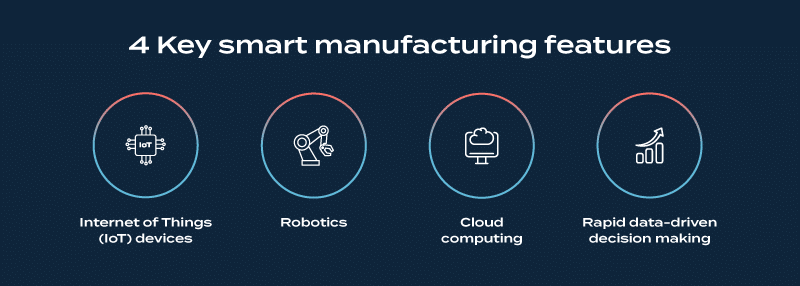
Digital transformation is one of the top business trends in South Africa, and in manufacturing, it’s resulted in the likes of smart factories that move from sporadic tech use to fully integrated smart systems.

“Digital transformation is reshaping the sector, enhancing efficiency, reducing costs, and improving product quality,” says Pieter Theron, Director of PwC South Africa. “Adopting Industry 4.0 tools and smart factory technologies is driving significant improvements in manufacturing efficiency and sustainability.”
We can break these advanced technologies down into four key smart manufacturing features:
Internet of Things (IoT) devices
This is an interconnected system of smart devices that use artificial intelligence (AI) and machine learning to communicate with each other. They often include sensors that collect data from machines and production lines, which AI then processes and analyses to identify patterns and trends.
Robotics
Robotics enhance smart factories by carrying out task automation, improving precision, and enabling 24/7 production. Integrated with AI, they optimise workflows and boost operational efficiency.
Rapid data-driven decision-making
Using advanced data analytics, manufacturers have exceptionally well-informed insights into their processes and can make better decisions faster than ever to eliminate uncertainty.
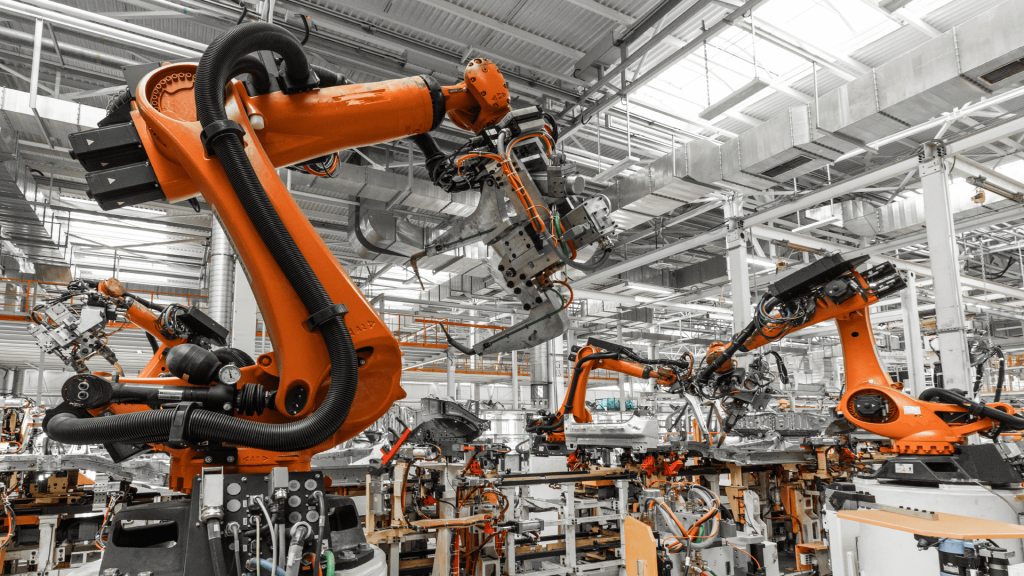
Cloud computing
Manufacturers can use data for systems at their own pace. Cloud computing provides a scalable platform for storing and analysing vast amounts of data collected from factory operations. Manufacturers can access this data remotely and integrate different systems at their own pace. Cloud solutions also enable easier collaboration and communication across multiple sites.
This by no means covers all the features of a smart factory, but they are the areas making the most impact at the moment. In fact, more than half (52%) of South African manufacturers have invested in cloud computing, according to PwC.
How South African companies can respond to this trend
A full-scale transition to smart technology is an expensive undertaking, but it promises to bring untold benefits in quality, efficiency and waste reduction.
The businesses that can integrate these practices into their business models the quickest will be the ones that benefit the most.
3. Digital twins are taking predictive maintenance to the next level
The manufacturing industry is embracing digital twins – virtual replicas of physical assets or systems – as the cornerstone of smarter, more efficient operations.
Digital twins work by collecting real-time sensor data to give manufacturers a crystal-clear view of their equipment’s performance. With this information, they can proactively optimise production and reduce costly downtime, which is thought to cost manufacturing companies $50 billion (around R933 million) annually.
Digital twins bring a wealth of advantages to manufacturers, including:
- Real-time monitoring
Anomalies are immediately detected and reported in real time via connected devices.
- Scenario testing
Companies can simulate conditions without affecting operations, meaning they can refine manufacturing processes risk-free.
- Lifecycle management
Digital twins provide insights that extend equipment life, by looking into wear patterns, performance metrics and maintenance schedules, so that manufacturers can make data-driven decisions.
It’s no wonder search interest in digital twin technology has surged by 143% over the past five years, according to Exploding Topics. Its high functionality makes predictive maintenance much more effective, reducing unplanned downtime by as much as 50% and increasing machine life by 20% to 40%.
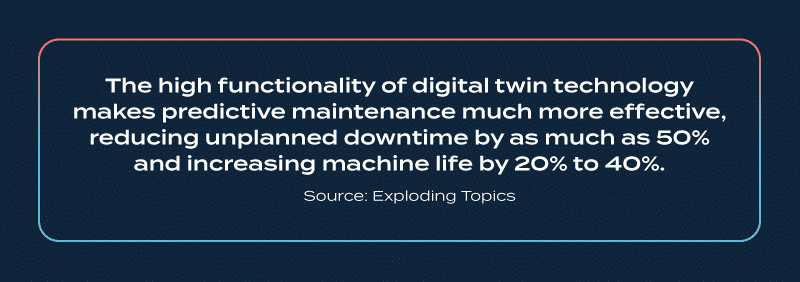
How South African companies can respond to this trend
Researching and investing in IoT-enabled devices and predictive analytics tools is a smart move in a fast-moving manufacturing sector.
It gives firms the accurate foresight they need to spot issues before they escalate, and keep production processes at an optimal level.
This may seem daunting, but companies can start with their most vital machinery and then increase coverage once they start seeing the benefits. These benefits are substantial, too, with prolonged machine life, less downtime and lower maintenance costs sure to outweigh investment costs over time.
4. Global supply chain challenges are accelerating reshoring efforts
Global disruptions such as raw material shortages, exchange rate fluctuations and economic uncertainty have made key parts of the supply chain more expensive for manufacturing businesses. Climate change, too, is affecting logistics by impacting the location and accessibility of materials.
It’s no surprise, then, that business leaders are looking at ways to restructure and diversify their company’s logistics. This includes a focus on creating flexible and reliable networks that can withstand sudden supply chain disruptions.
Take reshoring, for example. This involves moving production closer to home and adopting near-sourcing and multi-sourcing practices. Companies find that this helps reduce lead times, improve quality control and minimise the risks of long-distance shipping.
Such benefits are leading to what the IMTS refers to as a ‘manufacturing paradigm shift’, with supplier and manufacturing bases switching to local from global between 2022 and 2025.
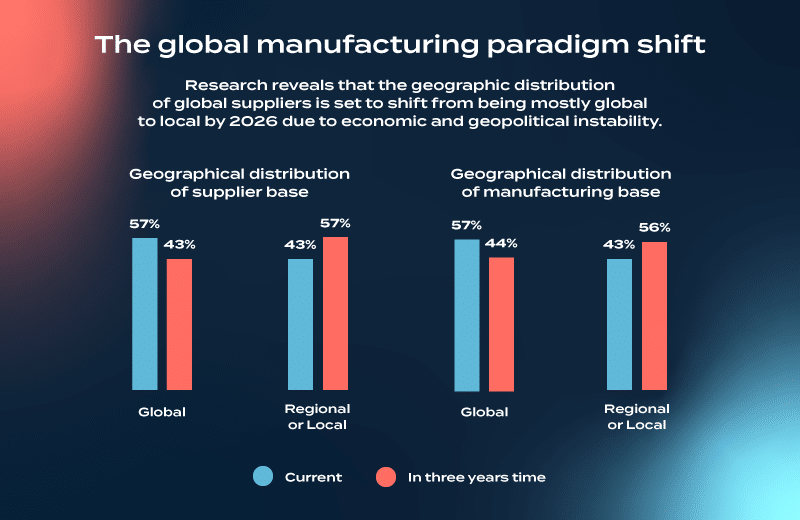
Employment stats back this trend up with over 2 million reshoring jobs reported in 2023, compared to less than half that figure before the pandemic.
How South African companies can respond to this trend
Keeping up with the cutting-edge trends in logistics and supply chain management is vital for manufacturing business growth.
In South Africa, reshoring and the shift towards regional supply chains present new opportunities for manufacturers to reduce their dependence on distant suppliers and pump up their supply chain resilience. This should help them cut costs and improve responsiveness.
With global logistics facing a turbulent future, this could turn out to be a savvy move several years down the line.
5. Strengthening cybersecurity in manufacturing
We’ve covered how manufacturing is hurtling headlong into widespread digitalisation, and businesses are prioritising cybersecurity to safeguard critical infrastructure and big data.
The growing use of connected ecosystems like IoT means companies are introducing advanced security measures to prevent cyberattacks and keep manufacturing operations flowing regardless of the disruption.
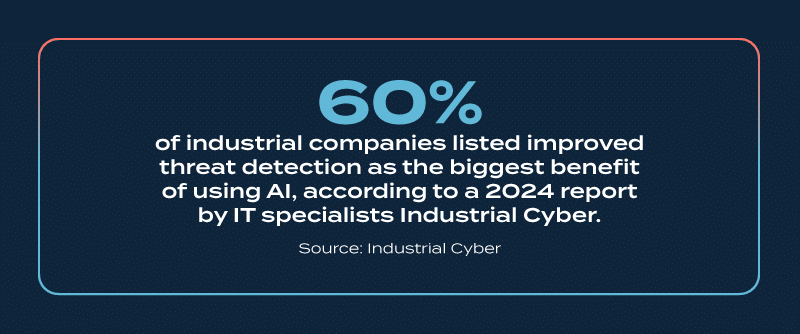
Fittingly, using artificial intelligence to guard against cybersecurity threats is becoming more popular. 60% of industrial companies listed improved threat detection as the biggest benefit of using AI, according to a 2024 report by IT specialists Industrial Cyber.
Zero-trust architecture, involving strict access controls, and advanced encryption are other popular ways that firms are contending with today’s unique cyber challenges.
How South African companies can respond to this trend
In South Africa, investing in cybersecurity education and upskilling can help build a skilled workforce to protect critical manufacturing infrastructure from digital threats. A strong focus on cybersecurity will protect businesses from costly data breaches and system downtime.
Manufacturers are taking proactive steps to secure their networks by introducing measures like advanced firewalls and intrusion detection. These help protect operational data and control systems from cyberattacks, including ransomware, which has become a growing concern for the industry.
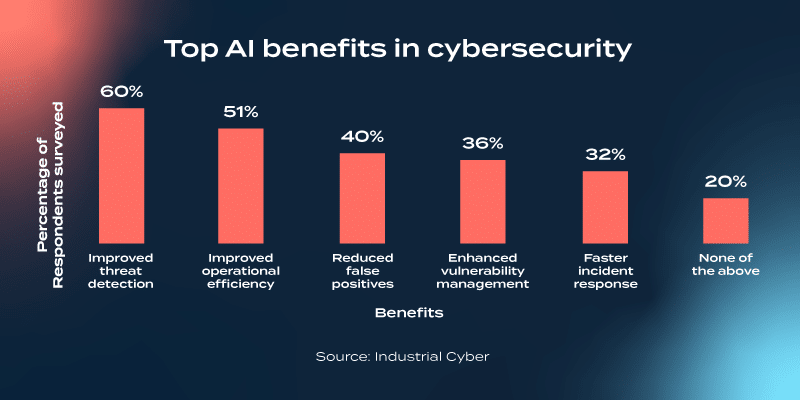
6. 3D printing goes mainstream
There’s a reason the global 3D printing industry is set to rocket in value from $7.5 billion (around R138 billion) to almost double that in 2028, according to The Business Research Company.

The technology, along with other additive manufacturing techniques, has improved massively in recent years.
3D printing enables manufacturers to simply print parts themselves and skip logistics delays.
They can carry out rapid prototyping, customisation and faster repairs than ever before. As the technology becomes more affordable and efficient, it reduces lead times, streamlines production processes and quickly produces replacement parts.
The savings that result from this are potentially huge, but the cost of setting up such facilities can also be high, which may restrict many businesses, especially smaller players.
How South African companies can respond to this trend
Adopting new technologies could be a boon for businesses in a country where such techniques are not as prominent as in other nations.
As ever, though, the cost of installing these facilities is a significant obstacle and it may be some time before businesses benefit from the associated cost savings.
Manufacturing finance is one solution to this conundrum and many alternative providers now provide much more flexible funding options than traditional lending methods.
Don’t let a lack of manufacturing finance hold you back. Apply for business funding today and get access to up to R5 million within as little as 24 hours.



